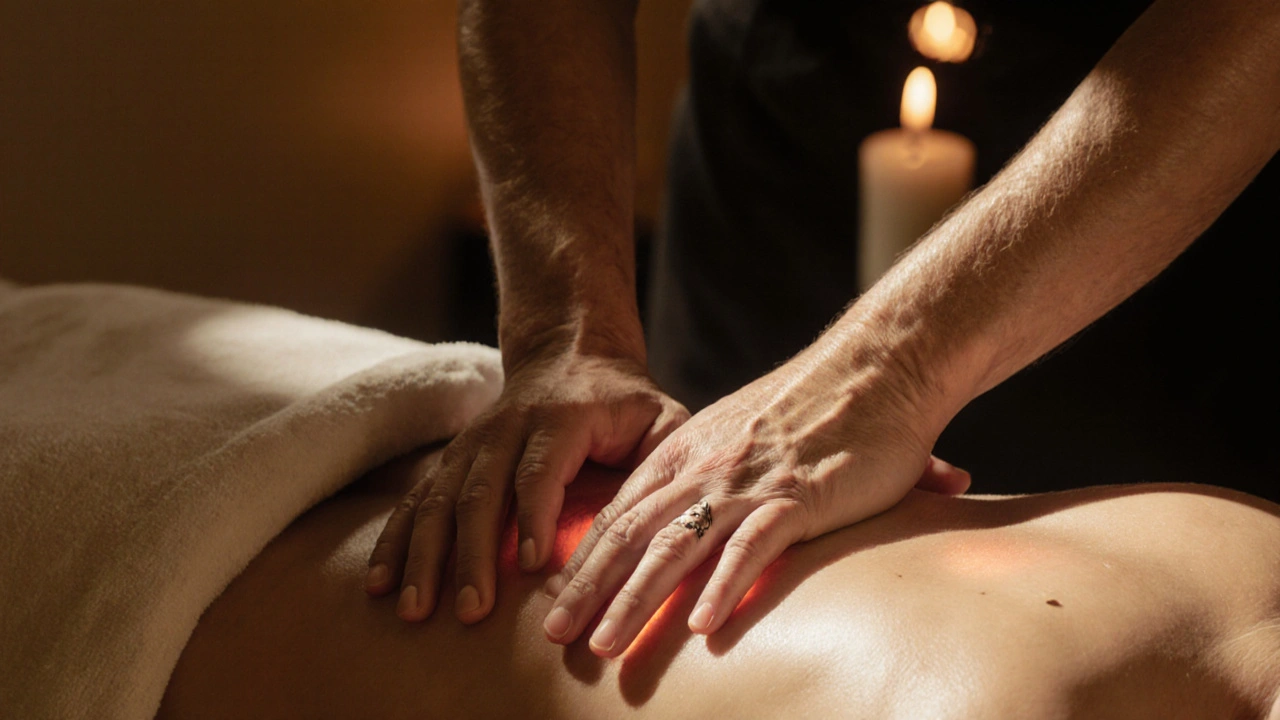Deep Tissue Massage Benefits: Why Regular Sessions Transform Wellness

There's something sneaky about tension. It slips into your neck, settles behind your shoulder blades, maybe even wraps itself around your lower back. What gives? Life, work, sleep—our bodies just suck it all in. Here’s the thing: regular deep tissue massage can untangle not just your muscles, but your whole sense of well-being. Most people who try it once only scratch the surface. The real magic happens when deep tissue work becomes part of your regular routine. We're not talking an occasional treat—think of it as maintenance for your body, kind of like changing the oil in your car, just a whole lot more relaxing.
How Deep Tissue Massage Unwinds the Body and Mind
Let’s pull back the curtain on what really happens when you get a deep tissue massage. It digs into those stubborn muscle knots—the technical term for these: adhesions. These little troublemakers are twisted up bundles of muscle fibers that limit movement, trap tension, and mess with circulation. During a deep tissue session, your massage therapist uses slow, firm strokes and sometimes even elbows, thumbs, or knuckles to target those knots. It's not just about brute force though. Skill matters a lot. Therapists have to feel what’s under the skin, releasing knots layer by layer without causing extra soreness.
Most people notice that after a session, not only does their range of motion improve, but they also breathe a little easier—literally. Muscles wrapped around the chest and shoulders can restrict our ability to take deep breaths when they're constantly tense. Releasing those tissues means more oxygen flow and, yes, more energy for your day. One fun fact: a 2014 study in the Journal of Alternative and Complementary Medicine reported marked reductions in lower back pain after just two weeks of regular deep tissue treatments. Results like these don't just come from random poking and prodding; deep knowledge of muscle anatomy truly matters. A well-trained therapist will work on the deeper muscle layers, including the fascia, a web of connective tissue that keeps everything *together*
Deep tissue massage pulls double duty for your body and your brain. Why? It triggers the release of feel-good hormones: serotonin, dopamine, and even oxytocin. People spot a drop in stress and anxiety, and some even feel sleepy as their “fight or flight” mode switches off. No wonder clients often leave with that post-massage daze. Ever find you’re a bit foggy-headed after? That’s your brain slowing down, savoring the rare chance to rest.
Another bonus: improved circulation. Manual pressure squeezes stagnant blood out of cramped muscles and draws fresh, oxygen-rich blood back in. That’s partly why you might see redness—called hyperemia—in the treated skin during or after a session. It’s a sign your tissues are coming alive again. So, when your therapist says to drink water after your treatment, they’re not just being polite. All that increased blood flow stirs up metabolic waste, and you want to flush that out to avoid feeling sluggish or sore the next day.
Let’s not forget the mind-body connection. Many regular clients say deep tissue work isn’t just for stiffness—it helps them “reset” emotionally, too. The deliberate, targeted pressure dials down the nervous system. Some unofficial polls show folks also sleep better after a session, likely due to reduced pain and decreased adrenaline. Not bad for what looks like an hour of lying around on a table, right?

What Happens When You Get Deep Tissue Massage Regularly?
It’s tempting to book a massage only when your back is in crisis. But science and therapists both agree: the biggest health wins kick in with consistent sessions. When you address chronic tension before it snowballs, you see fewer flare-ups and shorter recovery times. Athletes, desk jockeys, and weekend warriors alike report they bounce back from workouts or long workdays way faster after a few weeks of regular deep tissue appointments.
One often-overlooked benefit is how regular treatments improve body awareness. Imagine going months (or years) without noticing that you always carry tension on your right side or clench your jaw every time you answer work emails. When you get massage regularly, you actually become more attuned to how you hold yourself. Tiny imbalances and dysfunctional movement patterns are easier to spot—then fix. Your therapist can even give turbo-charged tips on stretches and simple movement tweaks to extend the effects between visits. Even elite sports teams now include deep tissue therapy in their training regimens for this reason.
Another smart tip: many insurance providers in the UK and abroad now list deep tissue massage under wellness plans if the sessions are recommended by a physiotherapist. That's not only a money-saver; it's validation that massage has shifted from luxury to legit health care.
It's not all bliss during the session (sometimes it really feels like your muscles are protesting)—but most fans say the long-term payoff outweighs a bit of temporary “good pain.” People frequently describe less pain in daily life, greater flexibility, and easier movement. Runners complain less about shin splints. Office workers find their tension headaches dial down or disappear. There’s even evidence it helps to manage the symptoms of conditions like fibromyalgia and sciatica, although always run health decisions past your doctor.
“More research is revealing the profound impact of massage on both physical pain and emotional resilience. Regular sessions can lower the body’s stress hormones, ease chronic muscle tightness, and promote healing,” says Dr. Tiffany Field, Director of the Touch Research Institute at the University of Miami.
Let’s bust a myth: Getting deep tissue regularly does not toughen up your muscles into an unbreakable fortress. Instead, it makes them more supple, responsive, and efficient. It’s like upgrading your body’s shock-absorbers so daily stress bounces off, not in. For anyone struggling with chronic posture issues or repetitive stress injuries, this can be life-changing. If you notice improvements after just a couple of visits, keep at it—lasting change is all about repetition.
There are a few practical tips, too. Book at consistent intervals—every two weeks works well for most, but listen to your body. Stay hydrated, eat something light before, and talk openly with your therapist about what feels right or too intense. The goal is always progress without overwhelming your system. After a few months, you’ll likely notice surprising benefits—better skin tone due to good circulation, easier mornings, even less anxiety as your “fight or flight” wiring settles down. It’s a cycle that keeps paying off as you stick with it.

Who Gains Most—and How to Get the Best Out of Deep Tissue Sessions
So who really walks away happier after regular deep tissue treatments? It's not only for pro athletes. Desk workers with round-the-clock screen time, parents with busy routines, and anyone juggling a fast-paced lifestyle sees real gains. People recovering from injuries—especially those dealing with stubborn scar tissue—often use deep tissue massage as a complement to physical therapy. It doesn’t replace doctor’s visits, but it can make other rehab way more effective.
If you’re new to regular sessions, here are a few insider tips for getting the most from your time on the table:
- Communicate early and often. Tell your therapist what hurts, what feels good, and what feels “off.” Adjusting pressure or focus points isn’t complaining—it’s collaborating.
- Don’t skimp on hydration. Your muscles are about 75% water. Think of deep tissue as a deep wringing out—rehydrate right after.
- Try to schedule massages when you don’t have back-to-back chores or meetings. Giving your body a break amplifies the benefits.
- Incorporate gentle stretching or movement a few hours after your session. You don’t want to undo all the good work, but some mild activity helps lock in the gains.
- Stick with a therapist whose style you connect with. Comfort and trust matter, especially when you’re going deep and targeting chronic issues.
Painful or tender areas deserve special attention, but you shouldn’t feel like you’re toughing it out every time. Good therapists work within your comfort zone, asking for feedback on pressure or discomfort. Don’t be surprised if they pick up on areas of tension you didn’t even know existed—tight hamstrings, for example, often show up during a session for people who sit all day, even if their legs don’t actually hurt.
For anyone worried about the “intensity” of deep tissue work: regular sessions actually make your body adapt and recover faster, so those initial post-massage aches tend to fade. Most regulars discover that their baseline soreness drops, and that “heavy, dull” feeling in their muscles becomes far less common. Mixing in lighter styles, like Swedish or lymphatic drainage massage, can help on off-days or between sessions.
People who’ve stuck with routine treatments often say the improvements aren’t just physical—they feel less irritable, sleep more soundly, and even notice their moods lifting in stressful times. And those are changes you can’t always measure in inches or milestones, but they matter just as much for quality of life.
If you’re still on the fence, here’s a quick list of what regular deep tissue massage can bring—even outside a spa:
- Faster recovery after workouts and physical labor
- Less muscle pain and tension-related headaches
- Better posture and easier movement, no matter your age
- Stronger immune response thanks to lower stress hormones
- Boosted movement confidence, especially for people with old injuries
So when people say that deep tissue massage is just a luxury, they’re missing the bigger picture. Used the right way, it’s more like routine body maintenance—a total game-changer for managing today’s non-stop pace and chronic stress. Your body will thank you for it, session after session. Real self-care isn’t always about bubble baths; sometimes, it’s trusting someone with skilled hands to help you release what you’ve been carrying for far too long.



